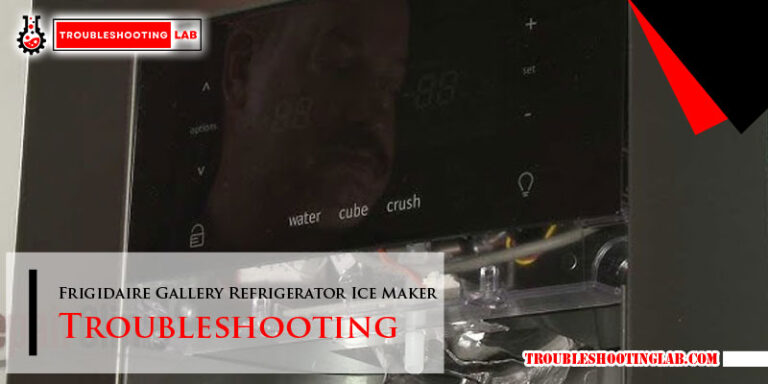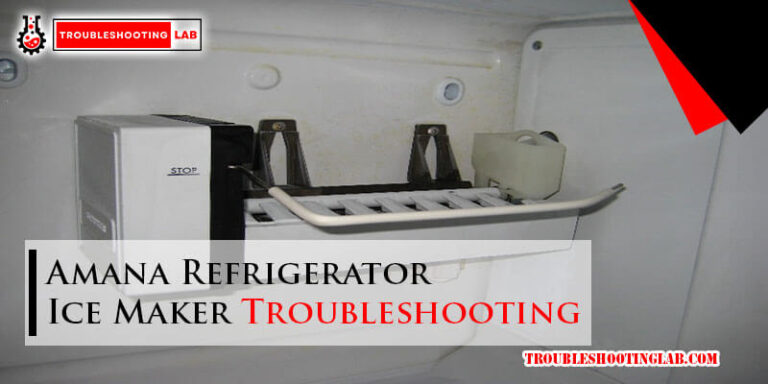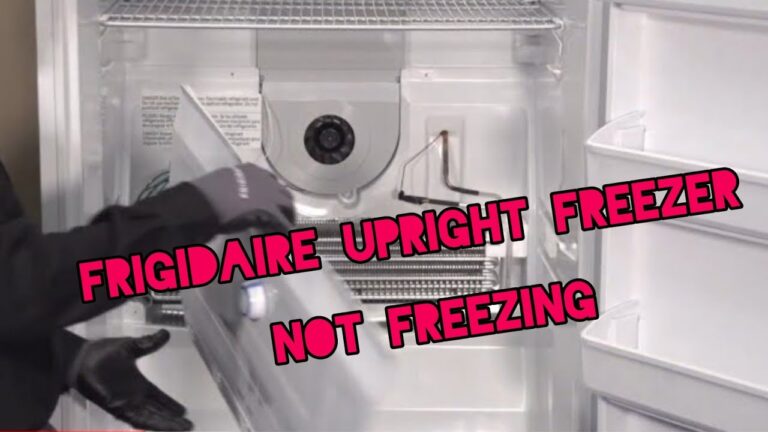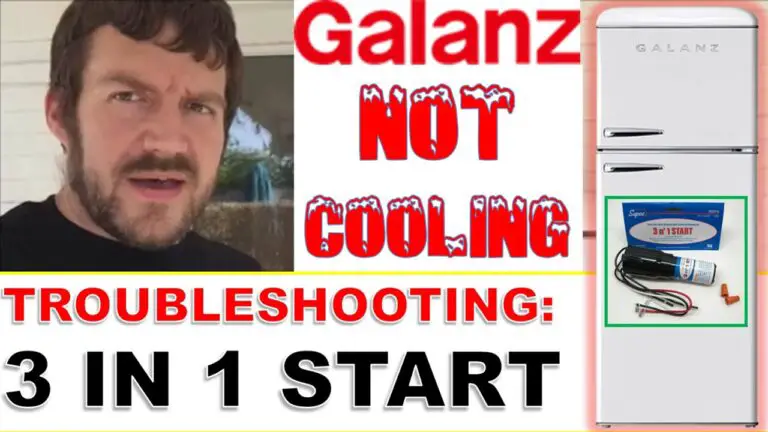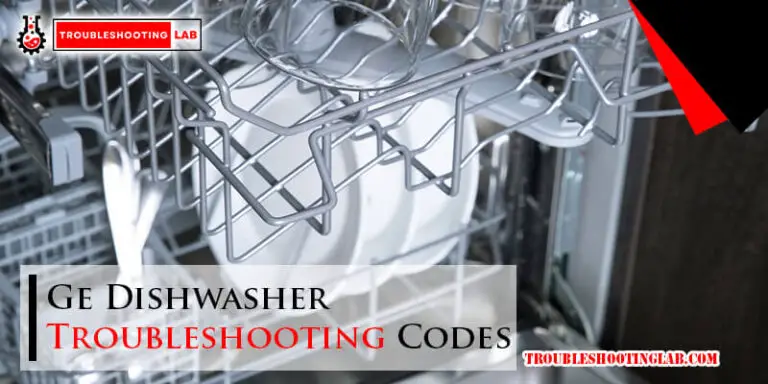Ge Side by Side Refrigerator Troubleshooting: Quick Fixes
Is your GE side-by-side refrigerator giving you trouble? Don’t worry—you’re not alone.
When your fridge isn’t cooling properly, makes strange noises, or leaks water, it can feel frustrating and overwhelming. But here’s the good news: you don’t always need to call a repair technician right away. Many common issues can be fixed quickly and easily with just a little know-how.
In this guide, we’ll walk you through simple troubleshooting steps that can save you time, money, and stress. Whether your fridge is acting up or you just want to be prepared for the unexpected, this article will help you take control of the situation. Ready to get your refrigerator back on track? Let’s dive in!

Credit: www.youtube.com
Common Issues
One of the most common frustrations with a GE side-by-side refrigerator is when it stops working as expected. Whether your fridge isn’t cooling, the freezer feels warm, or the ice maker has gone rogue, these issues can disrupt your day. Let’s break down the common problems and how you can troubleshoot them.
Refrigerator Not Cooling
Have you opened your fridge, only to find lukewarm milk or soft veggies? This usually happens when the temperature settings are incorrect or the condenser coils are dirty. Check your fridge’s thermostat—it might have been accidentally bumped to a warmer setting.
Dirty condenser coils can also be the culprit. Pull out your fridge and inspect the coils at the back or bottom. Use a vacuum or coil brush to remove dust and debris. This small step can often restore proper cooling.
Still no luck? Make sure the vents inside the refrigerator aren’t blocked by food items. Proper airflow is essential for consistent cooling.
Freezer Not Freezing
Is your ice cream melting instead of staying frozen solid? This often happens if the freezer temperature is set too high. Adjust it to the recommended setting—usually around 0°F (-18°C).
Another common issue is frost buildup. If you notice frost, it may indicate a problem with the defrost system. Defrost the freezer manually and monitor if the issue persists. If it does, you might need to check the defrost thermostat or heater.
Also, check the freezer door seal. A damaged or loose seal lets warm air in, making it harder for the freezer to stay cold. Replace the seal if it’s worn out.
Water Dispenser Malfunctions
When your water dispenser stops working, it’s tempting to think the worst, but it’s often a simple fix. First, check if the water supply line is connected and not kinked or blocked. A disconnected line is a common oversight.
If water flow is weak, the water filter might be clogged. Replace the filter if it’s been over six months since the last change. A fresh filter can make a noticeable difference.
Still not working? Inspect the dispenser switch. Press it and listen for a clicking sound. If there’s none, the switch might need replacing.
Ice Maker Problems
Is your ice maker refusing to make ice, or is it producing hollow cubes? Start by checking the water supply. A blocked or partially closed valve can disrupt ice production.
Ensure the ice maker is turned on—it’s easy to forget this step. Also, inspect the ice bin. Sometimes, an overfilled bin can stop the ice maker from working properly. Empty it out and reset the maker.
If the ice maker is leaking or freezing over, check the water inlet valve. A faulty valve may need replacement to fix the issue.
These troubleshooting steps can save you time and money. Have you faced any of these issues? Let us know in the comments how you resolved them—it might just help someone else!

Credit: www.searshomeservices.com
Basic Maintenance Tips
Keeping your GE side-by-side refrigerator in top shape doesn’t have to be a chore. A little regular maintenance can save you time, money, and frustration. Let’s dive into simple tasks you can do to ensure your refrigerator runs smoothly.
Checking Power Supply
Is your refrigerator not cooling properly? Start by checking its power supply. Ensure the power cord is securely plugged into the wall outlet and hasn’t been accidentally loosened.
Test the outlet with another device like a phone charger or lamp to confirm it’s working. If the refrigerator isn’t getting power, it could be due to a tripped breaker or faulty outlet. Address this quickly to prevent food spoilage.
Inspecting Door Seals
Door seals, also called gaskets, are often overlooked but vital for efficiency. A worn-out or loose seal lets warm air sneak inside, making your fridge work harder. Run your fingers along the edges to check for cracks or gaps.
To test the seal, place a dollar bill halfway inside the door and close it. If the bill slides out easily, your seal may need cleaning or replacement. Clean seals with warm, soapy water and dry them thoroughly to restore grip.
Cleaning Coils
Dirty coils can hurt your fridge’s performance and increase energy bills. You’ll typically find the coils at the back or underneath the refrigerator. Dust and debris can accumulate quickly, especially in homes with pets.
Unplug the fridge before cleaning for safety. Use a coil brush or vacuum attachment to remove buildup. Aim for coil cleaning twice a year—or more frequently if you notice reduced cooling power.
Adjusting Temperature Settings
Do you know the ideal temperature for your refrigerator? Experts recommend keeping it between 35°F and 38°F to keep food fresh and safe. Check the settings using the control panel or manual knobs inside the fridge.
If you notice food freezing or spoiling too quickly, tweak the settings slightly. Allow a few hours for the refrigerator to stabilize before rechecking. Small adjustments can make a big difference in performance.
Why wait for problems to appear? Implement these basic maintenance tips and enjoy peace of mind, knowing your GE side-by-side refrigerator is running efficiently. Which step are you most excited to try first?
Troubleshooting Cooling Problems
Dealing with cooling issues in your GE side-by-side refrigerator can be frustrating. No one likes opening the fridge to find their milk warm or veggies wilted. The good news? Most cooling problems can be resolved with a little troubleshooting. Let’s dig into some common causes and how you can fix them.
Blocked Air Vents
Air vents are essential for maintaining an even temperature inside your fridge. If they’re blocked by food containers or packaging, cold air won’t circulate properly.
Take a quick look inside your fridge. Are large boxes or bags pressed up against the back wall? Rearrange items so the vents stay clear and unobstructed. This simple step can make a big difference.
Faulty Thermostat
The thermostat controls the temperature inside your refrigerator. If it’s not working correctly, your fridge might not cool as it should.
Start by checking the thermostat setting. Is it set too low or too high? Adjust it to the recommended level (usually between 37°F and 40°F) and give it a few hours to stabilize. If the problem persists, the thermostat may need to be replaced.
Compressor Issues
Your refrigerator’s compressor is like its heart—it keeps everything running. If it fails, cooling stops altogether.
Listen for unusual noises, like constant clicking or humming, coming from the back of the fridge. These sounds could indicate a compressor problem. In this case, you’ll likely need to call a professional technician to diagnose and repair the issue.
Overloading The Refrigerator
Overstuffing your fridge can restrict airflow and cause uneven cooling. You might think you’re being efficient by packing it full, but it could be working against you.
Check how full your fridge is. If it’s overcrowded, remove excess items and leave space between them. This allows cold air to circulate freely, keeping everything evenly chilled.
Cooling problems don’t have to ruin your food—or your day. Which of these steps will you try first? Share your experience in the comments below!
Fixing Freezer Issues
A GE side-by-side refrigerator freezer should run efficiently to keep food fresh. Freezer issues can disrupt this and lead to spoiled food or wasted energy. Understanding common problems and their fixes can save time and money.
Here are three common freezer problems and how to troubleshoot them.
Frost Build-up
Frost can build up if warm air enters the freezer. This often happens when the door isn’t closed fully or seals are damaged. To fix this, inspect the door for obstructions. Check if items inside block the door from closing completely.
Manually defrost the freezer to remove excess frost. Unplug the refrigerator and leave the freezer door open. After the frost melts, clean the interior with a dry cloth before restarting the unit.
Damaged Door Gasket
A faulty door gasket lets warm air seep into the freezer. This can cause frost and uneven cooling. Inspect the gasket for cracks, tears, or dirt build-up. Clean the gasket with warm water and mild soap if it’s dirty.
If the gasket is damaged, replace it. You can purchase a compatible gasket online or from local stores. Installation is usually simple and doesn’t need professional help.
Clogged Drain Line
Freezers have a drain line to manage condensation. A clogged line can cause water to freeze and block airflow. Check for ice or debris in the drain line. Use a turkey baster or a warm water solution to clear it.
Pour warm water down the drain hole to melt ice. A small brush or pipe cleaner can help dislodge debris. Once clear, ensure the drain line flows freely before restarting the freezer.
Addressing Water Dispenser Errors
Is your GE side-by-side refrigerator’s water dispenser acting up? It’s frustrating when your appliance doesn’t work as expected, especially when you need a quick glass of water. Let’s tackle the common issues step-by-step so you can get back to enjoying a fully functioning refrigerator.
Low Water Pressure
Low water pressure can make your dispenser sluggish or even stop working altogether. Start by checking your home’s water supply line. A kinked or improperly connected line can reduce the flow of water.
If the line looks fine, test the water pressure. You can do this by disconnecting the water line and observing the flow directly. Slow flow? It may be time to call a plumber or look at your home’s water pressure regulator.
Ask yourself: Is your refrigerator getting the water it needs to perform properly?
Clogged Water Filter
A clogged water filter is one of the most common culprits behind dispenser errors. Filters trap impurities, but over time, they can get blocked. If your water filter hasn’t been changed in six months or longer, it’s likely overdue.
Check your GE refrigerator’s manual to locate the filter. Remove the old filter and replace it with a new one. Make sure it’s installed securely to avoid leaks or poor performance.
Pro tip: Always keep an extra filter handy to avoid downtime when your current one expires.
Air In Water Line
Air trapped in the water line can cause sputtering or inconsistent dispensing. This often happens after a new filter is installed or during initial setup. The good news? Fixing it is simple.
Dispense water continuously for a few minutes to purge the air. If air persists, disconnect the water line and reconnect it tightly to ensure a proper seal.
Ever wondered how such a small issue could cause such a big nuisance? It’s all about proper alignment and flow.
Addressing these issues doesn’t require professional help most of the time. With a little effort and attention to detail, you can restore your GE refrigerator’s water dispenser to perfect working condition. Keep these tips in mind the next time your dispenser acts up!

Credit: www.handyguyspodcast.com
Ice Maker Troubleshooting
The ice maker in a GE side-by-side refrigerator is a convenient feature. But, like any appliance, it can experience issues over time. Understanding common problems can help you troubleshoot effectively. Below are some common ice maker issues and how to address them.
Ice Not Dispensing
If the ice isn’t dispensing, first check the dispenser chute. It may be blocked by clumped ice or debris. Clear it carefully to avoid damage. Next, inspect the dispenser lever or button. Ensure it’s not stuck or damaged. Sometimes, the issue lies with the motor. If the motor isn’t running, it might need replacement. Verify that the control lock isn’t activated, as it can disable the dispenser.
Ice Cubes Too Small Or Hollow
Small or hollow ice cubes often indicate a water supply issue. Check the water line for kinks or blockages. Ensure the refrigerator’s water pressure meets the required level. Replace the water filter if it’s clogged, as this can restrict water flow. A dirty filter can also affect the ice quality. Regularly replacing the filter improves performance and water flow. Inspect the ice maker’s fill tube for ice blockages. Clear it if frozen water is restricting flow.
Ice Maker Not Filling
If the ice maker isn’t filling, check the water inlet valve. A faulty valve can prevent water from reaching the ice maker. Ensure the valve is open and functioning properly. Inspect the water line for leaks or kinks, which can restrict flow. Test the ice maker’s fill mechanism. If the mechanism is broken, it may need repair or replacement. Always confirm that the freezer temperature is cold enough. A warm freezer can stop the ice maker from working.
When To Call A Professional
Sometimes, troubleshooting your GE side-by-side refrigerator on your own isn’t enough. While DIY fixes can save time and money, certain problems require professional expertise. Knowing when to call a technician can prevent further damage and save you from costly repairs down the line.
Persistent Issues
If your refrigerator keeps showing the same problem after multiple attempts to fix it, it’s time to call a professional. For example, if your fridge constantly leaks water even after cleaning the drain tube, the issue might be deeper.
Electrical Component Failures
Major Repairs
Conclusion
Troubleshooting a GE side-by-side refrigerator doesn’t have to be overwhelming. Start with simple checks like power, temperature settings, and door seals. Regular maintenance can prevent many common problems. If issues persist, consult your manual or contact a professional. Taking small steps can save time and money in the long run.
Always prioritize safety when handling appliances. By addressing problems early, you can extend your refrigerator’s lifespan. A well-functioning fridge keeps your food fresh and your kitchen running smoothly. Stay proactive, and your refrigerator will serve you well for years to come.


